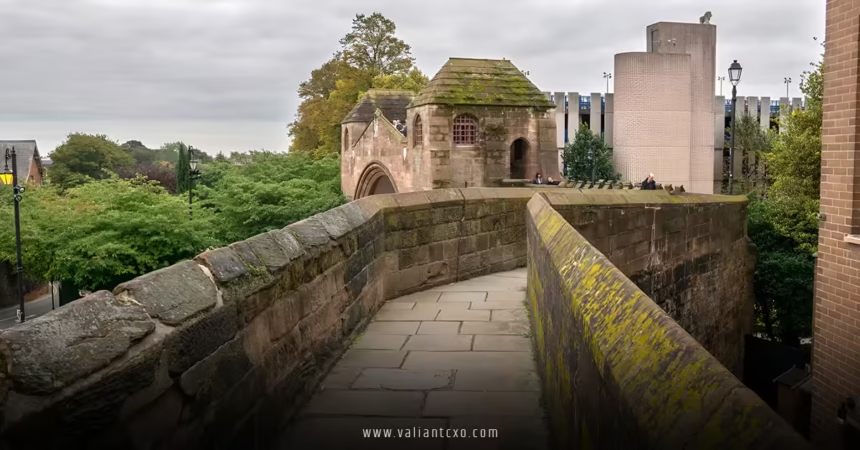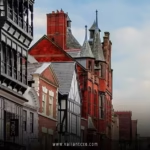Have you ever strolled through a city where the stones under your feet whisper tales from two millennia ago? That’s the magic of diving into the history of Chester Roman walls and landmarks. Nestled along the River Dee in Cheshire, England, Chester isn’t just any old town—it’s a living museum of Roman ingenuity and ambition, where ancient fortifications and grand structures still stand tall, inviting you to uncover their secrets.
Picture this: It’s the late 1st century AD, and the Roman Empire is pushing its boundaries across misty British shores. Chester, then known as Deva Victrix, emerges as a strategic powerhouse. But what makes this place so captivating? The history of Chester Roman walls and landmarks isn’t merely a dusty chapter in a history book; it’s a thrilling saga of conquest, construction, and cultural fusion that shapes the city even today. As we embark on this journey, I’ll guide you through the timelines, the builders, and the enduring legacy, all while keeping things light and relatable—like chatting over a cuppa about time-traveling Romans.
The Roman Conquest: Setting the Stage for Chester’s Foundations
Let’s rewind to the gritty beginnings. Why did the Romans zero in on this spot? Well, imagine you’re a legionary commander eyeing the map—Chester’s location at the River Dee’s estuary offered a perfect harbor for ships laden with supplies from across the empire. The history of Chester Roman walls and landmarks starts here, around AD 70, during the reign of Emperor Vespasian. The Romans, fresh from quelling tribal uprisings like those of the Brigantes, needed a foothold to control northern Wales.
By AD 74, under Governor Sextus Julius Frontinus, they established an auxiliary fort. But it was around AD 79 that things ramped up. Legio II Adiutrix, a crack unit of about 5,000 men, marched in and transformed the site into a full-blown fortress called Deva Victrix—”Victorious Deva,” named after the goddess of the river. Think of it as Rome’s unsinkable aircraft carrier on land: a base to launch campaigns into the wild Welsh hills.
This fortress wasn’t some flimsy camp; it sprawled over 25 hectares, with barracks, granaries, and headquarters that buzzed with disciplined activity. Agricola, the famous governor who later tamed much of Britain, stamped his name on lead pipes here—proof of high-level oversight. By AD 87, Legio II shipped out to the Danube, replaced by the trusty Legio XX Valeria Victrix, who called Deva home for over 300 years. These soldiers weren’t just fighters; they were engineers, farmers, and traders, laying the groundwork for the history of Chester Roman walls and landmarks that we admire today.
Rhetorical question time: What if Chester had been just another forgotten outpost? Instead, its strategic vibe turned it into a hub, complete with a civilian settlement (canabae) outside the walls, where merchants haggled over amphorae of wine and olive oil. This blend of military might and everyday life set the scene for monumental builds.
Building the Walls: Engineering Marvels of the Roman Era
Now, let’s get hands-on with the stars of the show—the walls. Ah, the history of Chester Roman walls and landmarks truly shines when we talk construction. Initially, the fortress was timber-framed, a quick-and-dirty setup for the legions. But around AD 100-102, under Emperor Trajan, they went big: stone walls rose like a colossal embrace around the site.
These weren’t your average barriers. The walls formed a rectangle about 520 meters by 420 meters, with massive sandstone blocks quarried locally—red and rugged, standing up to 10 meters high in places. Fronted by double ditches (berms) up to 9 meters wide and backed by earthen ramparts, they screamed “keep out.” Gates pierced the four sides: Porta Principalis (east), Porta Decumana (west), and the northern and southern ports. Towers dotted the perimeter for sentinels to scan the horizon.
But the history of Chester Roman walls and landmarks isn’t static; it’s a story of evolution. By the mid-2nd century, under Antoninus Pius, the walls saw tweaks—pottery shards from around AD 170 hint at ongoing occupation. Then came the turbulent 3rd century. Inscriptions from Emperor Elagabalus (AD 218-222) record repairs, and between AD 301-306, more fixes under Constantius Chlorus. The big rebuild? Late 3rd or early 4th century, when the north and west walls got a massive overhaul, possibly after a lull in activity. Some speculate abandonment during barbarian raids, but the walls endured, adapted with rounded bastions for better defense.
Materials? Sandstone ashlar for the facing, rubble core for strength—Roman concrete’s precursor. Walk the walls today, and you’ll spot original Roman bits amid medieval additions, like the half-timbered towers. It’s like a architectural patchwork quilt, each stitch telling a tale. Why so robust? Chester guarded trade routes and quelled Welsh revolts; these walls were the empire’s shield.
The Grand Spectacle: Unpacking the Chester Roman Amphitheatre
Shifting gears to one of the crown jewels in the history of Chester Roman walls and landmarks: the amphitheatre. Have you ever imagined 8,000 roaring spectators in a stone oval, cheering gladiators under the British sun? Built just outside the southeast fortress corner, this beast dates to the late 70s AD, courtesy of Legio II Adiutrix. It was a timber starter, but Legio XX rebuilt it in stone by AD 86—a whopping ellipse 98 meters by 87 meters, the largest in Britain.
Around AD 200, another upgrade doubled capacity, adding vaulted stairs and an outer wall with 2.7-meter foundations. Exits at cardinal points, a shrine to Nemesis (goddess of vengeance) at the north gate—perfect for blood sports. Uses? Not just gladiatorial gore; military drills sharpened legion skills, with mock battles echoing across the Dee. Artifacts like a Vespasian coin, gladius hilt, and Samian ware pots depicting fighters paint a vivid picture of rowdy fun.
By AD 275, after Hadrian’s Wall duties, Legio XX revived it, but by 350 AD, as Romans eyed the exit from Britain, it faded. Post-empire, it hosted bear-baiting and executions before silting over. Rediscovered in 1929, excavations from 2000-2006 revealed two phases—mind-blowing! Today, only the northern half is visible, with a trompe-l’œil mural tricking your eyes into seeing the full glory. Standing there, you feel the pulse of ancient crowds; it’s the heart of the history of Chester Roman walls and landmarks.
Analogy alert: The amphitheatre was Chester’s Colosseum lite—smaller scale, but no less thrilling, blending brutality with community spirit.
Beyond the Walls: Other Treasures in Chester’s Roman Tapestry
The history of Chester Roman walls and landmarks extends far beyond fortifications and arenas. Let’s wander to the Roman Gardens, a gem tucked near the amphitheatre. Created in 1949 to showcase excavated finds, these aren’t ancient per se but a brilliant display of Chester’s Roman soul. Stroll paths lined with columns from the gymnasium, carved friezes from the fortress, and a reconstructed hypocaust— that underfloor heating system Romans loved, channeling hot air like a toasty blanket on a chilly Dee evening.
Speaking of baths, the Roman bathhouse remnants under the old Blue Bell Inn (now museum turf) reveal tiled floors and steam rooms where soldiers unwound after drills. Nearby, the hypocaust at the Grosvenor Museum lets you peer into heated luxury—imagine soaking while plotting the next campaign.
Don’t miss the Northgate area, where Roman gate foundations lurk beneath medieval layers. And the elliptical building? A mysterious 2nd-century structure, possibly a temple or hall, sadly bulldozed in the 1960s for modern offices— a cautionary tale in the history of Chester Roman walls and landmarks. Then there’s the harbor quays, now inland due to silting, but once bustling with galleys unloading Italian marble and Gallic wine.
These spots weave a richer narrative: Chester wasn’t just a fort; it was a vibrant vicus, a mini-Rome with markets, workshops, and worship sites to gods like Minerva. Artifacts—pottery, altars, even a Mithras shrine fragment—evoke daily life. Why does this matter? It humanizes the empire; behind the walls, people lived, loved, and laughed.
From Roman Glory to Medieval Might: The Walls’ Enduring Evolution
As the 4th century waned, Romans pulled out around AD 410, leaving Deva to the winds. But the history of Chester Roman walls and landmarks didn’t end there—it pivoted. Saxons arrived, Vikings raided in 893, but Queen Aethelflaed refortified in 907, blending Roman stone with Saxon burh defenses.
Medieval Chester boomed: Normans built a castle in 1070 atop the Roman site, and the walls expanded to encircle the growing town, reaching today’s 2-mile loop by the 13th century. Gates like Eastgate got ornate clocks in 1899, and towers like the Phoenix (built 1325 on Roman foundations) added flair. Civil War sieges in 1642-46 tested the walls—Royalists held firm, pockmarking them with cannon scars you can still trace.
Yet, Roman roots persist: 70% of the circuit retains original masonry. Walk it, and you’re treading a timeline—Roman solidity underfoot, medieval charm overhead. It’s like layers of a cake, each era adding sweetness to the history of Chester Roman walls and landmarks.
Walking the Walls Today: Your Personal Time Machine
Fancy a jaunt through history? The history of Chester Roman walls and landmarks comes alive on a two-mile circuit walk—flat, accessible, and free. Start at the Eastgate Clock, that Victorian icon ticking atop Roman stones. Climb up, and voila: panoramic views of the Roodee racecourse (once the Roman harbor) and distant Welsh hills.
Pass the Cathedral, with its Roman undercroft, then the amphitheatre for a quick detour. Watergate offers Dee vistas, while the Boneshaker bridge sways poetically. Spot Roman angle towers, like the sturdy one near Bridgegate, rebuilt but rooted in antiquity. Apps and plaques guide you, turning the stroll into an interactive quest.
Pro tip: Dawn or dusk beats crowds; pair with a picnic for that Roman feast vibe. Families love it—kids spot “secret” towers, adults ponder empires’ rise and fall. In 2025, with heritage events ramping up, it’s prime time to immerse in the history of Chester Roman walls and landmarks.
Why Chester’s Roman Legacy Still Captivates Us
What pulls us back to these ancient stones? The history of Chester Roman walls and landmarks symbolizes resilience—empires crumble, but ingenuity lasts. Economically, tourism thrives: over a million visitors yearly pump life into shops and cafes. Culturally, it inspires—think festivals recreating gladiator bouts or wall-top concerts.
For beginners, it’s approachable: No PhD needed to feel the awe. Trust me, standing on those walls, you connect with ancestors who dreamed big. It’s a reminder: History isn’t past; it’s the ground we walk on.
In wrapping up our exploration of the history of Chester Roman walls and landmarks, we’ve journeyed from Deva’s founding to today’s vibrant trails. These walls and wonders aren’t relics—they’re bridges to the past, urging you to visit, touch, and time-travel. So, why not lace up your boots and step into the story yourself? Chester awaits, timeless and tantalizing.
FAQs
What role did the Roman legions play in the history of Chester Roman walls and landmarks?
The legions, like Legio XX Valeria Victrix, built the fortress and walls starting around AD 79, turning Chester into a key military base that shaped its enduring landmarks.
How long are the Chester Roman walls, and what makes them unique in the history of Chester Roman walls and landmarks?
Stretching about two miles, they’re the oldest and most complete Roman walls in Britain, blending original stone with later additions for a fascinating historical mix.
Can you visit the Roman Amphitheatre as part of exploring the history of Chester Roman walls and landmarks?
Absolutely! It’s open to the public, offering excavated views and a mural that recreates its glory— a must-see tied to the city’s Roman defenses.
What other Roman structures besides the walls contribute to the history of Chester Roman walls and landmarks?
Highlights include the Roman Gardens with hypocaust displays and bathhouse remnants, showcasing everyday Roman life alongside the grander fortifications.
How has the history of Chester Roman walls and landmarks evolved since the Roman era?
Post-Roman, Saxons and Normans adapted the walls for defense, leading to the medieval circuit we walk today, enriched by events like Civil War sieges.
For More Updates !! : valiantcxo.com


